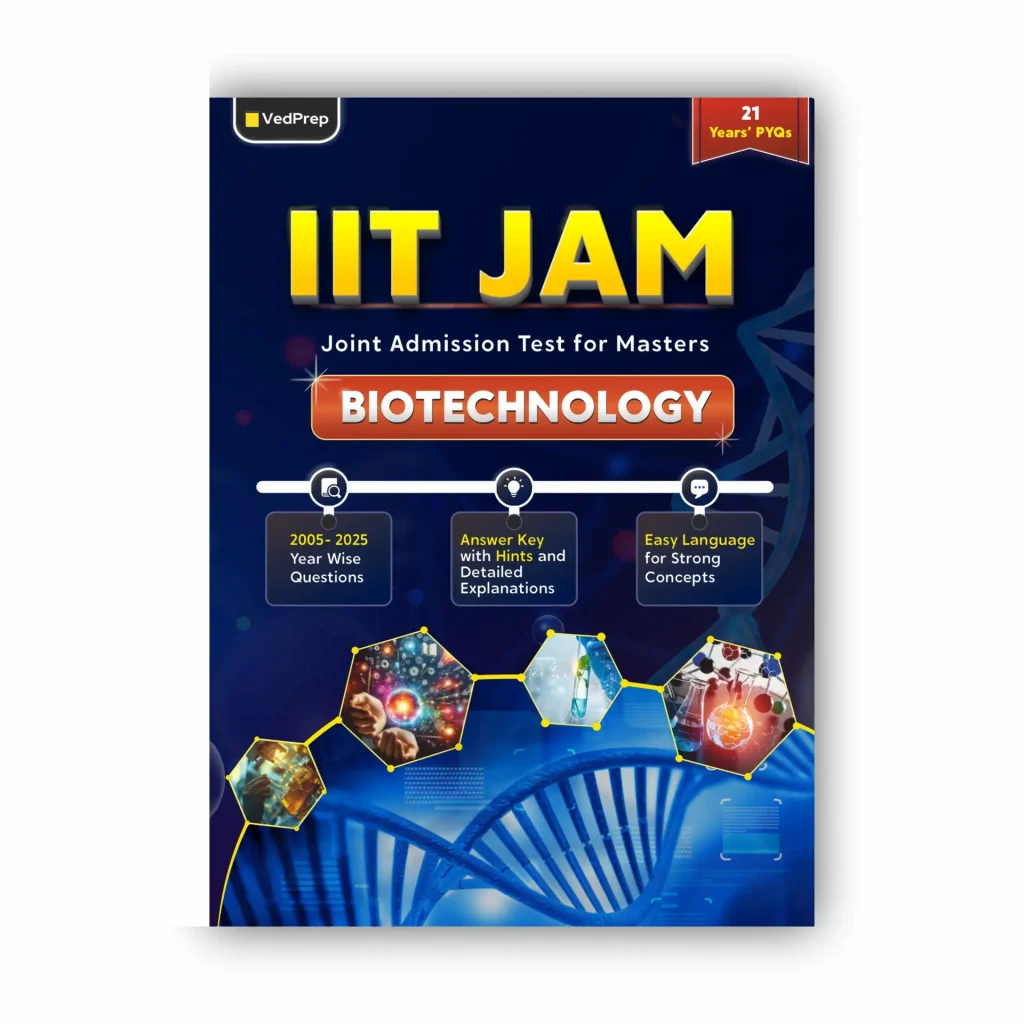CSIR NET Life Sciences Syllabus is carefully structured to evaluate both the theoretical knowledge and practical understanding of candidates in the field of life sciences. The exam is divided into three sections. Part A focuses on general aptitude, testing skills such as logical reasoning, quantitative ability, and analytical thinking. Part B contains subject-specific questions that cover the core areas of life sciences, while Part C presents higher-order analytical questions designed to assess a candidate’s scientific understanding and problem-solving capabilities. To ensure success, aspirants must devote attention to all three sections and prepare comprehensively according to the CSIR NET Life Sciences Syllabus 2025.

Also check – CSIR NET physics Science Previous Years Question Papers : Download PDFs
CSIR NET December 2025 Notification Key Details
The CSIR NET December 2025 notification is officially out, and aspirants can now start preparing for one of India’s most prestigious examinations in science and research. The exam is scheduled to be held on December 18, 2025, giving candidates a clear timeline to plan their preparation.
Important Dates
- Online Application Start: September 25, 2025
- Application Deadline: October 24, 2025 (till 11:50 PM)
- Exam Date: December 18, 2025
Eligibility Criteria
Candidates interested in applying for the CSIR NET December 2025 exam must meet the following eligibility requirements:
- A Master’s degree in a relevant science subject.
- Minimum 55% marks in the Master’s degree (50% for reserved categories).
Application and Exam Details
All applications, admit cards, and results for the CSIR NET December 2025 exam will be available on the official website: csirnet.nta.nic.in. Candidates are advised to check the website regularly for updates and official notifications.
Also check – CSIR NET Previous Year Question Papers Download PDF

CSIR NET Life Sciences Syllabus 2025 Overview
Aspirants planning for the CSIR NET Life Sciences Exam 2025 should be well aware of the syllabus, exam pattern, and important details. Familiarity with the exam structure helps candidates plan their preparation efficiently and cover all important areas of the CSIR NET Life Sciences Syllabus 2025.
Exam Details
| Event | Details |
| Exam Name | CSIR NET December 2025 |
| Organized by | National Testing Agency (NTA) |
| Medium of Examination | Hindi & English |
| Mode of Examination | Computer-Based Test (CBT) |
| Exam Date | 18th December 2025 |
| Time Duration | 3 hours |
| Maximum Marks | 200 |
| Number of Questions | 145 |
| Negative Marking | 25% for each wrong answer |
| Exam Pattern | Part A: 20 questions (General Aptitude) – Answer any 15
Part B: 50 questions (Life Sciences) – Answer any 35 Part C: 75 questions (Life Sciences, analytical) – Answer any 25 |
| Age Limit | JRF: 28 years; Relaxation: SC/ST/PH/Female – up to 5 years; OBC (Non-creamy layer) – up to 3 years |
| Official Website | csirnet.nta.nic.in |
CSIR NET Life Sciences Syllabus 2025 PDF
The CSIR NET Life Sciences Syllabus 2025 is now officially available for download. This syllabus covers all essential topics required for the exam, including Molecular Biology, Developmental Biology, Cellular Organization, Genetics, Plant and Animal Physiology, Cell Signaling, Evolution, Ecology, Applied Biology, and Methods in Biology. Candidates preparing for the exam should refer to the PDF to get a detailed overview of the syllabus and plan their preparation accordingly.
You can download the CSIR NET Life Sciences Syllabus PDF 2025 from the official NTA website: csirnet.nta.nic.in.
Detailed CSIR NET Life Sciences Syllabus 2025
| Unit No. | Unit Name |
| 1 | Structure and Function of Biomolecules |
| 2 | Cellular Organization |
| 3 | Fundamental Processes |
| 4 | Cell Communication and Cell Signaling |
| 5 | Developmental Biology |
| 6 | System Physiology – Plant |
| 7 | System Physiology – Animal |
| 8 | Inheritance Biology |
| 9 | Evolution and Diversity of Life Forms |
| 10 | Ecology and Behavioural Biology |
| 11 | Bioinformatics and Computational Biology |
| 12 | Biochemical Engineering and Industrial Biotechnology |
| 13 | Advances in Biotechnology |
| 14 | Methods in Biology |
CSIR NET Life Sciences Syllabus Unit 1 – Structure and Function of Biomolecules
| Topic Code | Sub-Topics |
| A | Structure of atoms, molecules and chemical bonds |
| B | Composition, structure and function of biomolecules (carbohydrates, lipids, proteins, nucleic acids, vitamins) |
| C | Stabilizing interactions: van der Waals, electrostatic, hydrogen bonding, hydrophobic interactions |
| D | Principles of biophysical chemistry: pH, buffer, reaction kinetics, thermodynamics, colligative properties |
| E | Bioenergetics: glycolysis, oxidative phosphorylation, coupled reactions, group transfer, biological energy transducers |
| F | Principles of catalysis, enzymes, enzyme kinetics, regulation, catalytic mechanisms, isozymes |
| G | Conformation of proteins: Ramachandran plot, secondary structure, domains, motifs, folds |
| H | Conformation of nucleic acids: A-, B-, Z-DNA structures; RNA conformations |
| I | Stability of proteins and nucleic acids |
| J | Metabolism of carbohydrates, lipids, amino acids, nucleotides, vitamins |
CSIR NET Life Sciences Syllabus Unit 2 – Cellular Organization
| Topic Code | Sub-Topics |
| A | Cell Wall and Cell Membrane: Structure & Function
• Cell wall • Physical structure of membranes in prokaryotes & eukaryotes • Lipid bilayer, membrane proteins • Diffusion, osmosis, ion channels • Active transport, membrane pumps • Sorting & regulation of intracellular transport • Electrical properties of membranes |
| B | Structural Organization & Function of Intracellular Organelles
• Nucleus: organization & dynamics • Mitochondria, Golgi bodies, lysosomes • Endoplasmic reticulum, peroxisomes, plastids • Vacuoles, chloroplasts • Cytoskeleton: structure & function, role in motility |
| C | Organization of Genes & Chromosomes
• Operon • Unique & repetitive DNA • Interrupted genes • Gene families • Chromatin structure • Heterochromatin & euchromatin • Transposons |
| D | Cell Division & Cell Cycle
• Mitosis & meiosis • Regulation of cell division • Steps of cell cycle • Regulation & control of cell cycle • Apoptosis, necrosis, autophagy |
| E | Microbial Physiology
• Growth kinetics • Strategies of cell division • Stress response • Antimicrobial resistance (AMR) |
CSIR NET Life Sciences Syllabus Unit 3 – Fundamental Processes
| Topic Code | Sub-Topics |
| A | DNA Replication, Repair and Recombination
• Unit of replication • Enzymes involved • Replication origin & replication fork • Fidelity of replication • Extrachromosomal replicons • DNA damage & repair mechanisms • Homologous & site-specific recombination |
| B | RNA Synthesis, Processing and Regulation
• Mechanism & regulation of transcription • Transcriptional inhibitors • Transcription factors & machinery • Activators & repressors • RNA polymerases • Capping, RNA processing, editing, splicing, polyadenylation • Types of RNA: structure & functions • RNA transport • Ribozyme, riboswitches, non-coding RNAs |
| C | Protein Synthesis, Processing and Degradation
• Ribosome • Mechanism & regulation of translation • Translational inhibitors • Post-translational modification • Protein trafficking & transport • Protein degradation |
| D | Control of Gene Expression
• Gene regulation in phages, viruses, prokaryotes & eukaryotes • Role of chromatin in gene expression & silencing • Epigenetic regulation |
CSIR NET Life Sciences Syllabus Unit 4 – Cell Communication and Cell Signaling
| Topic Code | Sub-Topics |
| A | Cell Signaling
• Hormones & their receptors • Cell surface receptors • G-protein coupled receptor (GPCR) signaling • Signal transduction pathways • Second messengers • Regulation of signaling pathways • Bacterial & plant two-component systems • Light signaling in plants • Bacterial chemotaxis & quorum sensing |
| B | Cellular Communication
• General principles of cell communication • Cell adhesion & adhesion molecules • Gap junctions • Extracellular matrix (ECM) • Integrins • Neurotransmission & its regulation • Regulation of haematopoiesis |
| C | Innate & Adaptive Immune System
• Cells & molecules of innate/adaptive immunity • Antigens, antigenicity, immunogenicity • B & T cell epitopes • Antibody: structure & function • Antibody diversity, monoclonal antibodies, antibody engineering • Antigen–antibody interactions • MHC molecules: antigen processing & presentation • Activation/differentiation of B & T cells • BCR & TCR • Humoral & cell-mediated responses • Primary & secondary immune modulation • Complement system • Toll-like receptors • Cell-mediated effector functions • Inflammation, hypersensitivity, autoimmunity • Immune response in bacterial, parasitic & viral infections • Congenital & acquired immunodeficiencies • Vaccines |
| D | Host–Pathogen Interaction
• Recognition & entry of pathogens (bacteria, viruses) into plant/animal cells • Alteration of host behaviour by pathogens • Virus-induced cell transformation • Pathogen-induced diseases in plants & animals • Cell–cell fusion in normal & abnormal cells |
| E | Cancer Biology
• Genetic rearrangements in progenitor cells • Oncogenes & tumor suppressor genes • Cancer & the cell cycle • Virus-induced cancers • Metastasis • Interaction of cancer cells with normal cells • Therapeutic interventions for uncontrolled cell growth |
CSIR NET Life Sciences Syllabus Unit 5 – Developmental Biology
| Topic Code | Sub-Topics |
| A | Basic Concepts of Development
• Potency, commitment, specification, induction, competence • Determination & differentiation • Morphogenetic gradients • Cell fate & lineages • Stem cells • Genomic equivalence, cytoplasmic determinants • Imprinting • Use of mutants & transgenics in developmental studies |
| B | Gametogenesis, Fertilization & Early Development
• Production of gametes • Sperm–egg recognition (cell surface molecules) • Zygote formation, cleavage, blastula formation • Embryonic fields, gastrulation, germ layer formation (animals) • Male gametophyte development (plants) • Embryo sac development, double fertilization • Plant embryogenesis • Establishment of symmetry in plants • Seed formation, embryo & endosperm development • Seed germination |
| C | Morphogenesis & Organogenesis in Animals
• Cell aggregation & differentiation (Dictyostelium) • Axes & pattern formation: Drosophila, amphibians, chick • Organogenesis: vulva formation (C. elegans), eye lens induction • Limb development & regeneration (vertebrates) • Neuronal differentiation • Post-embryonic development: larval stages, metamorphosis • Environmental regulation of development • Sex determination |
| D | Morphogenesis & Organogenesis in Plants
• Shoot & root apical meristem organization • Shoot & root development • Leaf development & phyllotaxy • Transition to flowering • Floral meristems, floral organogenesis & development |
| E | Programmed Cell Death, Aging & Senescence
• PCD in animals & plants • Aging mechanisms • Senescence processes in animals & plants |
CSIR NET Life Sciences Syllabus Unit 6 – System Physiology Plant
| Topic Code | Sub-Topics |
| A | Photosynthesis
• Light harvesting complexes • Electron transport mechanisms • Photoprotective mechanisms • CO₂ fixation pathways: C3, C4, CAM |
| B | Respiration & Photorespiration
• Citric acid cycle • Plant mitochondrial electron transport & ATP synthesis • Alternate oxidase • Photorespiratory pathway |
| C | Nitrogen Metabolism
• Nitrate & ammonium assimilation • Amino acid biosynthesis • Biological nitrogen fixation |
| D | Plant Hormones
• Hormone biosynthesis, storage, breakdown & transport • Physiological effects • Mechanisms of hormone action |
| E | Sensory Photobiology
• Light perception mechanisms • Phytochromes, cryptochromes, phototropins: structure & function • Stomatal movement • Photoperiodism • Biological clock |
| F | Solute Transport & Photoassimilate Translocation
• Uptake & movement of water, ions, solutes, macromolecules • Transport across membranes • Xylem and phloem transport • Transpiration • Loading & unloading of photoassimilates |
| G | Secondary Metabolites
• Biosynthesis of terpenes, phenolics, alkaloids, phenylpropanoids, nitrogenous compounds • Roles of secondary metabolites • Metabolic engineering in plants |
| H | Stress Physiology
• Plant responses to biotic & abiotic stresses • Physiological & molecular adaptations • Plant innate immunity |
CSIR NET Life Sciences Syllabus Unit 7 – System Physiology Animal
| Topic Code | Sub-Topics |
| A | Blood and Circulation
• Blood corpuscles • Haemopoiesis, formed elements • Plasma function • Blood volume & regulation • Blood groups • Haemoglobin • Immunity • Haemostasis |
| B | Cardiovascular System
• Comparative heart anatomy • Myogenic heart • Specialized cardiac tissues • ECG: principle & significance • Cardiac cycle • Heart as a pump • Blood pressure • Neural & chemical regulation |
| C | Respiratory System
• Respiration in different species • Anatomical adaptations • Gas transport & exchange • Waste elimination • Neural & chemical regulation |
| D | Nervous System
• Neurons • Action potential • Neuroanatomy: brain & spinal cord • CNS & PNS • Neural control of muscle tone & posture |
| E | Sense Organs
• Vision • Hearing • Tactile responses |
| F | Excretory System
• Comparative excretion physiology • Kidney structure & function • Urine formation & concentration • Micturition • Water balance, blood volume & BP regulation • Electrolyte & acid–base balance |
| G | Thermoregulation
• Comfort zone • Body temperature regulation: physical, chemical, neural • Acclimatization |
| H | Stress and Adaptation |
| I | Digestive System
• Digestion & absorption • Energy balance • Basal Metabolic Rate (BMR) |
| J | Endocrinology & Reproduction
• Endocrine glands • Hormone action mechanisms • Hormones & related diseases • Reproductive processes • Gametogenesis • Ovulation • Neuroendocrine regulation |
| K | Metaorganisms / Holobionts
• Gut microbiome in physiology • Gut microbiome research methods • Germ-free animals • Gut–brain axis • Dysbiosis & disease |
| L | Interorgan Communication & Energy Homeostasis
• Metabolic health • Metabolic disorders |
CSIR NET Life Sciences Syllabus Unit 8 – Inheritance Biology
| Topic Code | Sub-Topics |
| A | Chromosomal & Extrachromosomal Inheritance
• Mendelian principles • Codominance & incomplete dominance • Penetrance & expressivity • Gene interactions, pleiotropy • Genomic imprinting • Linkage & crossing over • Sex-linked inheritance • Mitochondrial & chloroplast inheritance • Maternal inheritance |
| B | Genes & Mutations
• Alleles, multiple alleles, pseudoalleles • Complementation tests • Types of mutations & their causes • Detection of mutations • Lethal, conditional, biochemical mutants • Loss-of-function, gain-of-function, dominant-negative mutations • Germinal vs somatic mutations |
| C | Genetic Analysis
• Linkage maps • Molecular marker mapping (plants/animals/bacteria) • Tetrad analysis • Gene transfer in bacteria: transformation, conjugation, transduction, sex-duction • Fine structure mapping • Mapping population development in plants |
| D | Human Genetics
• Pedigree analysis • LOD score for linkage • Karyotypes • Genetic disorders |
| E | Quantitative Genetics
• Population genetics • Hardy–Weinberg equilibrium • Polygenic inheritance • Heritability & measurement • Molecular mapping |
| F | Structural & Numerical Chromosomal Alterations
• Recombination • Deletion, duplication, inversion, translocation • Ploidy (polyploidy, aneuploidy) & genetic consequences |
CSIR NET Life Sciences Syllabus Unit 9 – Evolution and Diversity of Life Forms
| Unit | Topic | Sub-Topics Covered |
| A | Evolution of Life and Life Forms | • Origin of life and early evolution
• Evolution of cellular structures, functions & multicellularity • Mechanisms of evolution: natural selection, genetic drift, gene flow, mutation • Mechanisms of speciation • Extinction events & their impact on biodiversity • Adaptive radiation & convergent evolution • Coevolution & evolutionary arms races • Human evolution |
| B | Principles & Methods of Taxonomy | • Species concepts & hierarchical classification
• Biological nomenclature • Classical methods of taxonomy • Quantitative taxonomy of plants, animals & microorganisms |
| C | Microbial Life | • Bacteria & Archaea: diversity & ecological roles
• Viruses: structure, replication, effects on life • Economically & medically important microbes |
| D | Protists | • Algae
• Protozoa • Slime molds & water molds • Ecological roles of protists |
| E | Fungi | • Groups: chytrids, zygomycetes, glomeromycetes, ascomycetes, basidiomycetes
• Important plant & human fungal pathogens |
| F | Plant Life | • Evolution & diversity of land plants: bryophytes, ferns, gymnosperms, angiosperms
• Plant morphology & anatomy • Plant reproduction |
| G | Animal Life | • Evolutionary relationships of invertebrates & vertebrates
• Key characteristics of major animal groups |
CSIR NET Life Sciences Syllabus Unit 10 Ecology and Behavioral Biology
| Unit | Topic | Sub-Topics Covered |
| A | Introduction to Ecology | • Levels of organization: individual, population, community, ecosystem, biosphere
• Abiotic & biotic ecological factors • Ecological adaptations |
| B | Population Ecology | • Population growth models: exponential & logistic growth
• Density-dependent & density-independent factors • Life tables & survivorship curves • Age structure, sex ratio, r- & K-strategies • Metapopulations: fragmentation, connectivity & extinction risk |
| C | Community Ecology | • Community structure: food webs, trophic levels, keystone species
• Species interactions: competition, predation, mutualism, parasitism • Succession: primary & secondary succession; community stability |
| D | Ecosystem Ecology | • Energy flow: primary production, trophic levels, energy pyramids
• Biogeochemical cycles: carbon, nitrogen, phosphorus, water • Ecosystem services & human impacts |
| E | Human Impacts on Ecosystems | • Land-use & land-cover change
• Climate change & pollution • Invasive species & anthropogenic pressures |
| F | Biodiversity and Conservation | • Biodiversity & its significance
• Threats to biodiversity • IUCN threat categories • Conservation genetics & PVA • Ex-situ & in-situ conservation • Community-based conservation & indigenous knowledge • National & international conservation policies |
| G | Acts and Policies | • Biodiversity Act 2002
• Agricultural biodiversity • International Treaty on PGRFA • Conservation strategies for seed gene banks • Climate change & plant genetic resources • PPVFR & Biodiversity Act strategies |
| H | Behavioural Ecology | • Introduction to animal behaviour: proximate & ultimate causes
• Foraging behaviour & communication • Conflict, aggression & territory • Migration, dispersal & navigation • Social behaviour • Sexual selection & mating systems • Parental care |
CSIR NET Life Sciences Syllabus Unit 11 Bioinformatics and Computational Biology
| Unit | Topic | Sub-Topics Covered |
| A | Major Bioinformatic Resources | • Sequence databases (DNA, RNA, protein)
• Gene expression databases • 3D structure databases • Pattern & sequence motif databases |
| B | Basic Concepts of Sequence Analysis | • Database searches
• BLAST, FASTA • Sequence identity vs similarity • Homologues, orthologues, paralogues • Repeat finding • Scoring matrices (PAM, BLOSUM) • Pairwise sequence alignment • Multiple Sequence Alignment (MSA) • Applications in taxonomy & phylogeny • Comparative genomics |
| C | Gene Annotation | • Predicting gene function using homology, genomic context, structures, networks
• Genetic variation: polymorphisms, deleterious mutations • Phylogenetics |
| D | Molecular Modelling & Dynamics | • 3D structure visualization
• Molecular modeling basics • Molecular mechanics & simulations • Force fields (AMBER, CHARMM etc.) |
| E | Protein 3D Structure Classification & Comparison | • Anatomy of proteins
• Hierarchical structure (primary → quaternary) • Secondary & tertiary structure prediction • Homology/comparative modeling • Fold-recognition & threading • Ab initio structure prediction • AI-based prediction (AlphaFold, others) |
| F | Drug Design | • Chemical databases (NCI, PubChem)
• Receptor–ligand interactions • Structure-based drug design (SBDD) • Ligand-based drug design (LBDD) • SAR, QSAR & pharmacophores • In-silico prediction of drug activity & ADMET properties |
| G | Systems Biology | • Data science applications in biology & drug discovery
• Mathematical modelling of metabolic pathways & diseases • Digital health • Personalized medicine |
Unit 12 Biochemical Engineering and Industrial Biotechnology
| Unit | Topic | Sub-Topics Covered |
| A | Introductory Mathematics | • Calculus review
• Ordinary differential equations • Higher-order differential equations • Linear algebra basics • Numerical methods |
| B | Engineering Principles | • Material & energy balance
• Steady-state balances • Properties of pure substances • Transport phenomena basics • Momentum transfer • Heat & mass transfer • Introduction to mass transfer equipment |
| C | Thermodynamics in Biological Systems | • First & second laws of thermodynamics
• Biological systems as open, non-equilibrium systems • Why classical thermodynamics fails for biological processes • Thermodynamic flux & force concepts • Entropy production • Constitutive equations • Thermodynamics of coupled biochemical reactions • Oxidative phosphorylation—thermodynamic analysis • Glycolytic oscillations & biological clocks |
| D | Bioprocess Engineering & Technology | • Microbial growth principles & influencing factors
• Growth kinetics: batch, fed-batch, continuous • Types of bioreactors: batch, fed-batch, plug-flow, continuous, enzyme reactors • Sterilization principles • Mass & energy balance in microbial processes • Dissolved oxygen effects • Oxygen mass transfer, aeration, agitation • Fluid rheology • Fermentation technology for: antibiotics, organic acids, alcohols, bioplastics, vitamins, enzymes • Steroid biotransformation • Process flow sheet & process economics |
| E | Enzymes & Microbial Technology | • Enzymes in organic solvents & ionic liquids
• Biocatalysts • Enzyme engineering (random & rational design) • Biocatalysis applications • Immobilization of enzymes & whole cells • Design & operation of immobilized enzyme reactors • Kinetics of immobilized systems • Diffusional resistance & Thiele modulus |
| F | Downstream Processing | • Biomass removal & cell disruption
• Precipitation (salts, solvents) • Membrane-based purification • Adsorption & chromatography • Extraction: solvent, aqueous two-phase, supercritical • Drying technologies |
| G | Bioprocess Plant Design | • General design guidelines
• Process flow sheet development • Scale-up & scale-down considerations • Scale-up of downstream processing • Equipment selection & specifications |
| H | Metabolic Engineering & Synthetic Biology | • Concepts of metabolic engineering
• Pathway optimization • Synthetic gene circuits • Genome editing approaches (CRISPR, etc.) • Applications in industrial biotechnology |
CSIR NET Life Sciences Syllabus Unit 13 Advances in Biotechnology
| Unit | Topic | Sub-Topics Covered |
| A | Recombinant DNA Technology | • Molecular cloning
• Expression of recombinant proteins • In vitro mutagenesis & deletion techniques • Gene knockout in bacteria & eukaryotes • Genome editing techniques (CRISPR, TALEN, ZFN etc.) • Protein sequencing methods • DNA sequencing methods • Genome sequencing strategies • Gene expression analysis methods |
| B | Medical Biotechnology | Immunology Applications: Autoimmunity, transplantation, tumor immunology
• Stem cell therapy • Cell-based vaccines Vaccines: Live, killed, attenuated, subunit, recombinant nucleic acid vaccines • Diagnostics & adjuvants • Cell therapy & immunotherapy • Recombinant DNA–based therapy • Antibody engineering, phage display libraries • Tissue engineering Stem Cell Technology: iPSCs, guided/directed differentiation, applications in drug screening & disease biology Organoids: 3D stem-cell-based models Neurobiology: Electrophysiology, behavioral tests Medical Devices: Implants & biosensors |
| C | Animal Biotechnology | • Transgenic animals
• Modern animal breeding techniques • Germplasm conservation • Genetic health monitoring • Molecular medicine & surgery • Molecular diagnosis of pathogens • Cell cloning & selection • Cell & tissue culture methods for biotechnological applications |
| D | Agricultural Biotechnology | • Transgenic plants
• Molecular diagnostics & strain identification • Plant genomics & applications • EST (Expressed Sequence Tags) development • Molecular markers for genotyping & germplasm analysis • Marker-assisted breeding (MAB) • Foreground & background selection • Gene introgression & pyramiding • Non-gel–based genotyping techniques • Impact of GE (Genetically Engineered) crops on biodiversity • Plant tissue & cell culture techniques • Plantibodies |
| E | Marine Biotechnology | • Important marine organisms, biology & behavior
• Marine resource assessment • Population studies & marine ecosystem protection • Role of microbes in marine environments • Microbial metabolites • Seafood microbiology • Marine pharmacology • Biofouling, corrosion & marine biofilms • Basics of oceanography |
| F | Environmental Biotechnology | • Wastewater treatment technologies
• Pollution control strategies • Environment-friendly biotech solutions • Biosurfactants, biofertilizers, biopesticides • Microbially enhanced oil recovery (MEOR) • Integrated waste management systems • Biogas & biofuel production from waste • Bioremediation & phytoremediation |
CSIR NET Life Sciences Syllabus Unit 14 METHODS IN BIOLOGY
| Unit | Topic | Sub-Topics Covered |
| A | Molecular Biology Techniques | • Isolation, separation & analysis of macromolecules (DNA, RNA, proteins, lipids, carbohydrates)
• Chromatography (paper, TLC, HPLC, ion-exchange, affinity, gel filtration) • Electrophoresis (agarose, PAGE, SDS-PAGE, IEF) • Centrifugation (differential, density-gradient, ultracentrifugation) |
| B | Biophysical Methods | • Spectroscopy: UV-Vis, fluorescence, CD, NMR, ESR
• Molecular structure determination: X-ray diffraction, cryo-EM, NMR • Light scattering methods • Mass spectrometry types (MALDI-TOF, ESI, LC-MS/MS) • Surface Plasmon Resonance (SPR) |
| C | Genomics, Transcriptomics, Proteomics & Metabolomics | • Genome structure (prokaryotes vs eukaryotes)
• Comparative genomics • Global gene expression analysis • Comparative & differential transcriptomics • Protein–protein interaction mapping • Targeted & untargeted metabolomics • DNA fingerprinting, DNA barcoding • Single-cell sequencing, single-cell omics |
| D | Radiolabeling Techniques | • Detection & measurement of radioisotopes
• Incorporation in tissues & cells • Molecular imaging of radioactive material • Radio-safety guidelines |
| E | Histochemical & Immunotechniques | • Antibody generation
• ELISA, RIA, Western blot • Immunoprecipitation • Flow cytometry • Immunofluorescence microscopy • Live-cell molecular detection • In situ localization: FISH, GISH |
| F | Microscopic Techniques | • Light microscopy
• Advanced microscopy techniques • Resolving power & resolution limits • Microscopy of living cells • SEM, TEM • Sample preparation for microscopy |
| G | Electrophysiological Methods | • Single-neuron recording
• Patch-clamp technique • ECG • Brain activity recording • Brain lesion & stimulation techniques • Pharmacological testing • Imaging: PET, MRI, fMRI, CT/CAT |
| H | Methods in Field Biology | • Population density estimation
• Ranging patterns (direct, indirect, remote sensing) • Behavioural sampling methods • Habitat characterization (ground surveys, satellite/remote sensing) |
| I | Statistical Methods | • Precision & accuracy, signal-to-noise ratio
• Central tendency & dispersion • Probability distributions: Binomial, Poisson, Normal • Sampling distribution • Parametric vs non-parametric tests • Confidence interval, errors, significance levels • Regression & correlation • t-test, ANOVA, Chi-square test • Basics of multivariate statistics |
| J | IPR, Biosafety & Bioethics | • Intellectual Property Rights; types of IP
• Patent databases • Biosafety measures & levels (BSL-1 to BSL-4) • Regulatory guidelines for biological work • Animal ethics & research ethics |
CSIR NET Life Sciences Exam Pattern 2025
A clear understanding of the CSIR NET Life Sciences Exam Pattern 2025 is essential for candidates to plan their preparation effectively. The exam is structured to test general aptitude, subject knowledge, and higher-order analytical skills through three parts: Part A, Part B, and Part C.
Exam Pattern Overview
| Section | Total Questions | Questions to Attempt | Marks per Correct Answer | Negative Marking |
| Part A (General Aptitude) | 20 | 15 | 2 | 0.5 |
| Part B (Life Sciences) | 50 | 35 | 2 | 0.5 |
| Part C (Life Sciences, Analytical) | 75 | 25 | 4 | 1 |
| Total | 145 | 75 | – | – |
| Maximum Marks | – | – | – | 200 |
Key Points About the Exam Pattern
- Part A tests general aptitude, including logical reasoning, quantitative ability, and analytical skills.
- Part B focuses on subject-specific knowledge in core areas of life sciences.
- Part C includes higher-order analytical questions to assess scientific understanding and problem-solving skills.
- Candidates must attempt the required number of questions in each part carefully, keeping in mind the negative marking scheme.
By understanding the CSIR NET Life Sciences Exam Pattern 2025, aspirants can prioritize topics, allocate time efficiently, and develop a strategy to maximize scores in all three sections.
|
Related Topics |
|
| important topics for csir net Physical Science | important topics for csir net Life Science |
| important topics for csir net Chemistry | important topics for csir net Mathematics |
CSIR NET Life Sciences Exam Preparation Tips
Before you start your study plan, take a look at these essential CSIR NET Life Sciences preparation tips designed to boost your overall performance.
| Preparation Tip | Description |
| Understand the Syllabus | Go through the complete CSIR NET Life Sciences syllabus and divide it into sections such as Part A, Part B, and Part C for systematic study. |
| Focus on Important Topics | Give extra attention to high-weightage subjects like Molecular Biology, Genetics, Cell Biology, and practice them regularly. |
| Time Management | Create a realistic study schedule, allotting fixed hours to each subject to maintain consistent progress. |
| Practice Previous Papers | Solve previous years’ question papers to understand the exam pattern and question trends. |
| Make Short Notes | Prepare brief notes on key concepts and formulas to help during last-minute revision. |
| Revise Regularly | Keep a weekly or bi-weekly revision cycle to retain concepts effectively before the exam. |
CSIR NET Life Sciences 3-Month Study Timetable (90 Days)
If you want a structured and result-oriented strategy, this CSIR NET Life Sciences 90 Days Study Plan will guide you through every step of your preparation.
Structure
- Month 1 (Days 1–30): Complete Basics + Core Units
- Month 2 (Days 31–60): Advanced Units + Part-C Focus
- Month 3 (Days 61–90): Revision + PYQs + Mock Tests
Month 1: Foundation & Core Units (Days 1–30)
| Week | Day Plan | Topics Covered |
| Week 1 (Days 1–7) | 3–4 hrs/day | Cellular Organization, Biomolecules, Biophysical Chemistry |
| Week 2 (Days 8–14) | 4 hrs/day | Fundamental Processes: DNA Replication, Transcription, Translation |
| Week 3 (Days 15–21) | 4 hrs/day | Gene Regulation, Operons, RNA Processing |
| Week 4 (Days 22–30) | 4–5 hrs/day | Cell Signaling, Cancer Biology, Immunology (Innate + Adaptive) |
Month 2: Advanced Units + Part-C Mastery (Days 31–60)
| Week | Day Plan | Topics Covered |
| Week 5 (Days 31–37) | 4–5 hrs/day | Developmental Biology: Gametogenesis → Organogenesis |
| Week 6 (Days 38–44) | 4 hrs/day | Inheritance Biology: Mendelian, Linkage, Gene Mapping, Mutations |
| Week 7 (Days 45–51) | 4–5 hrs/day | System Physiology – Plant: Photosynthesis, Respiration, Nitrogen Cycle |
| Week 8 (Days 52–60) | 4–5 hrs/day | System Physiology – Animal: Nervous, Cardiovascular, Respiratory Systems |
Month 3: Mock Tests + PYQs + Full Revision (Days 61–90)
| Week | Day Plan | Focus Area |
| Week 9 (Days 61–67) | 4 hrs/day | Diversity of Life Forms + Ecology + Evolution |
| Week 10 (Days 68–74) | 4–5 hrs/day | Applied Biology + Methods in Biology (scoring) |
| Week 11 (Days 75–82) | 3 hrs/day | Complete Syllabus Revision (Make short notes + charts) |
| Week 12 (Days 83–90) | 2–3 hrs/day | Solve 10 Full-Length Mock Tests + PYQs Analysis |
Daily Timetable
| Time | Task |
| 1 hour | Theory Reading (NPTEL/Books/Notes) |
| 1 hour | MCQs of Part B |
| 1 hour | Part C Numerical/Analytical Questions |
| 30 mins | Revision of previous topics |
| 30 mins | Flashcards/Diagrams/Short Notes Revision |
Weekly Targets
- Complete 1–2 units per week
- Solve 250–300 MCQs weekly
- Do 1 mini mock test every Sunday
CSIR NET life Science Previous Year Question Papers PDF Download
Here is a list of CSIR NET Life Sciences previous year question papers available for download.
| CSIR NET Previous Year Question Papers PDF (2022) | ||
| Subjects | Exam Shift | Download Link |
| Life Science | Shift 1 | PDF Download |
| Shift 2 | PDF Download | |
| CSIR NET Previous Year Question Papers PDF (2020) | ||
| Subjects | Exam Shift | PDF Download Link |
| Life Science | Shift 1 | PDF Download |
| Shift 2 | PDF Download | |
| CSIR NET Previous Year Question Papers PDF (2019) | |
| Subject | PDF Download |
| Life Sciences | PDF Download |
Importance of CSIR NET Previous Year Question Papers
CSIR NET previous year question papers are invaluable for the exam preparation, and the CSIR NET is no exception. Here’s why:
- Understanding the Exam Pattern: Familiarize yourself with the question types, marks distribution, and difficulty level, helping in better planning.
- Identifying Repeated Topics: Recognize recurring topics to focus on during preparation, optimizing study time.
- Time Management Practice: Practice solving papers under timed conditions to develop efficient time allocation skills.
- Improving Accuracy: Gain confidence and increase accuracy by understanding the exam format.
- Boosting Confidence: Regular practice simulates exam conditions, reducing anxiety and boosting confidence.
- Self-assessment: Evaluate strengths and weaknesses to adjust the study plan for improvement.
Also Check CSIR NET Notes
CSIR NET life Science Syllabus 2025 FAQs
What topics are included in CSIR NET Life Science Syllabus 2025 Part A?
Part A of CSIR NET Life Science Syllabus 2025 includes logical reasoning, numerical ability, data interpretation, quantitative analysis, analytical skills.
What topics are covered in CSIR NET Life Science Syllabus 2025 Part B?
Part B of the CSIR NET Life Science Syllabus 2025 covers molecular biology, genetics, cell biology, physiology, signaling, developmental biology, evolution, ecology.
What is included in CSIR NET Life Science Syllabus 2025 Part C?
Part C of the CSIR NET Life Science Syllabus 2025 tests higher-order skills via analytical questions from all major life science units.
How to prepare for CSIR NET Life Science Syllabus 2025 effectively?
Follow a 3-month timetable, solve PYQs, practice Part C numericals, revise key units weekly, use MCQs, follow the CSIR NET Life Science Syllabus 2025 structure.
What are common topics students search in CSIR NET Life Science Syllabus 2025 PDF free download?
Queries include CSIR NET Life Science Syllabus 2025 PDF free download, exam pattern, eligibility, topic list, unit-wise syllabus, mock tests, PYQs.














